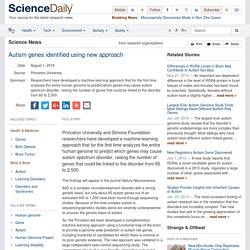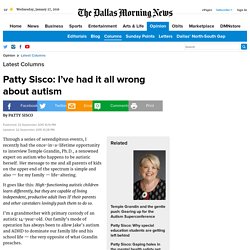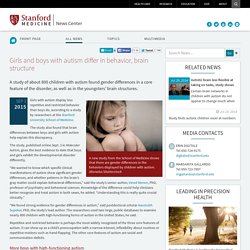

The dark side of social media: Baroness Susan Greenfield says social media is rewiring our brains. WE’RE all guilty of it.

We’re at the pub, dinner table or enjoying a fun arvo with a group of friends and, instead of talking to the people we’re with, we’re preoccupied with our phones. Facebook, Instagram, Twitter, video games and — dare I say it — news.com.au all provide endless distractions, as well as more opportunities to share, connect and spout your views than ever before. But what effect is this having on us? More crucially, how is it affecting our brains? Renowned British neuroscientist Baroness Susan Greenfield says modern technology is not only changing the way we interact, it is changing the wiring in our brain. Autism genes identified using new approach. Princeton University and Simons Foundation researchers have developed a machine-learning approach that for the first time analyzes the entire human genome to predict which genes may cause autism spectrum disorder, raising the number of genes that could be linked to the disorder from 65 to 2,500.

The findings will appear in the journal Nature Neuroscience. ASD is a complex neurodevelopment disorder with a strong genetic basis, but only about 65 autism genes out of an estimated 400 to 1,000 have been found through sequencing studies. Because of the how complex autism is, sequencing/genetics studies alone are severely underpowered to uncover the genetic basis of autism. About Us - Autism Society of Tidewater Virginia. The Autism Society, Tidewater Virginia is local affiliate of the Autism Society of America, which has over 100 chapters across the United States.We are a locally funded organization that celebrates over 30 years of dedication towards improving the lives of all affected by autism in the Tidewater Virginia Region.

Established as a volunteer organization, Autism Society, Tidewater Virginia has relied solely on people with autism, families and professionals who volunteer thousands of hours to help us achieve our mission of serving those affected by autism. In 2007, we hired our first part-time, staff member, Ms. Angel Barnhill. She serves as our Resource Director. MISSION: Autism Society, Tidewater Virginia serves the Tidewater community and beyond, to include the Peninsula, by promoting autism awareness and providing autism-related education, resources, and services. Patty Sisco: I’ve had it all wrong about autism. Through a series of serendipitous events, I recently had the once-in-a-lifetime opportunity to interview Temple Grandin, Ph.D., a renowned expert on autism who happens to be autistic herself.

Her message to me and all parents of kids on the upper end of the spectrum is simple and also — for my family — life-altering. It goes like this: High-functioning autistic children learn differently, but they are capable of living independent, productive adult lives IF their parents and other caretakers lovingly push them to do so. Unstable blood vessels seen in autistic brains. When researchers examined human postmortem brain tissue—some from typical brains and others from those with an autism diagnosis—they found evidence of changes to blood vessels in autistic brains.

“Our findings show that those afflicted with autism have unstable blood vessels, disrupting proper delivery of blood to the brain,” explains Efrain Azmitia, a biology professor at New York University and senior author of the study published in the Journal of Autism and Developmental Disorders. “In a typical brain, blood vessels are stable, thereby ensuring a stable distribution of blood,” adds Azmitia. “Whereas in the autism brain, the cellular structure of blood vessels continually fluctuates, which results in circulation that is fluctuating and, ultimately, neurologically limiting.” Girls and boys with autism differ in behavior, brain structure.
“Autism has primarily been studied from the viewpoint of boys with the disorder,” said Menon, who holds the Rachael L. and Walter F.

Nichols, MD, Professorship. “Understanding gender differences can help in identifying the behavioral skills that are most important to remediate in girls vis-a-vis boys.” The study examined the severity of autism symptoms in 128 girls and 614 boys registered with the National Database for Autism Research. The children ranged in age from 7 to 13, had IQ scores above 70, and had been evaluated with standard tests for autistic behavior.
The boys and girls were matched for age, and had the same average IQ.